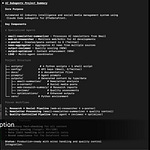We're entering a new phase where the line between user and creator is disappearing. It's no longer "I wish there were an app for that," but "I think I can build it."
The digital revolution turned passive consumers into content creators, powering Google, Meta, and TikTok through user-generated content. Now AI is driving the next leap: turning consumers into software producers.
At Thoughts From the DataFront, we've been tracking this shift—how AI is democratizing technology and putting sophisticated tools within anyone's reach.
This week, instead of just talking about it, I'm showing it.
Every month, my wife Jess and I dread reviewing our credit card statements, trying to figure out where our money went. So I turned this monthly headache into a perfect test case for everything we discuss here on this blog.
What I Built
Using Claude with some additional custom tools - I built an AI-powered system that transforms any credit card statement into financial analysis with savings recommendations— delivered to my email in under 2 minutes.
How It Works
Step 1: Read & Categorize - AI reads the PDF, extracts 100+ transactions, and categorizes each purchase into logical groups.
Step 2: Analyze & Visualize - It creates a Google Sheets database and an interactive chart
Step 3: Recommend & Deliver to Email - It generates money-saving recommendations for each category sent to my email.
The entire process that would typically take hours of spreadsheet work happened automatically.
Why This Matters
This isn't just about one credit card statement. It's proof that the AI democratization we've been discussing is real and accessible to everyone right now.
Using Claude AI integrated with Zapier, Google Sheets, and Gmail, anyone can build this through conversation—no coding expertise required.
Remember, the future belongs to people who can think clearly about problems and communicate those needs to AI. The technology is ready. What will you build first?
Your Next Move: Watch the demo in this post, then message me with problems you're trying to solve. Let's figure out how AI can tackle them together.







